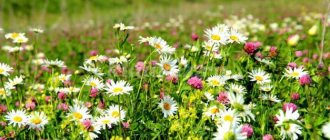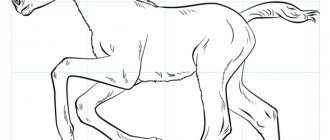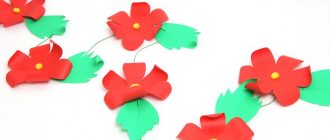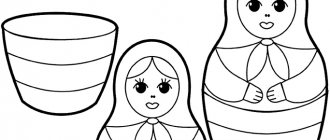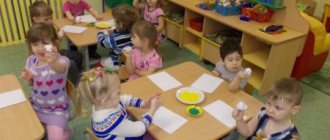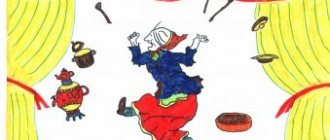Drawing notes for the preparatory group "Blue Flowers of Gzhel".
Behind business and worries, a quiet blue winter evening unnoticed falls to the ground... (Reading by the teacher of V. Fetisov’s poem “Winter Evening”)
A winter evening lit up the blue stars in the blue sky. The branches are pouring blue frost onto the blue snowball. Behind the branches the house turns blue, Covered with blue wool. Shadows walk along the wall like a bluish net. The frost paints blue in the windows of the forget-me-nots, And the blue dog yawns near the blue booth.
Maybe because the snow around is so dazzlingly white, and the evening shadows of Gzhel are so blue, and the frosty patterns on the windows are blue, and the sky above the village is clear azure, and Gzhel craftsmen chose blue paint on a snow-white background to paint their dishes. And since during the long winter we still dream about spring, master artists painted spring fairy-tale flowers with frosty patterns.
(Poem by A. Pleshcheev “Snowdrop”)
The last snowball has not yet melted, but the snowdrop flower is looking tenderly. After him, the violet woke up from sleep, She opened her purple eye. Here the lily of the valley turns white in the calm of the forest, the forget-me-not looks, bending over the stream.
The paints of the Gzhel masters have a secret: a nondescript gray powder (called cobalt), and the pattern on the dishes is gray. almost black. And as soon as they cover the finished crafts with glaze for shine and put them in the oven again for hardening, they will sparkle with magical blue and blue colors.
These are the wonderful works the Gzhel masters produced. (Showing reproductions and illustrations)
And the fame of the wonderful flowers of Gzhel spread throughout the world. Products from Gzhel craftsmen are considered a luxurious gift. The secrets of the craft have been passed down from generation to generation for more than 650 years.
In previous lessons we made forms for painting made from papier-mâché, and today we will try to paint them. Let's learn from real Gzhel masters.
The main elements of Gzhel painting are “wide and narrow stripe”, “dot”, “wave”, “bush”, “petal”, “mesh”, “leaf”. Display on a display sheet attached to the board.
A special technique that distinguishes Gzhel painting is the “stretching” of color, from dark blue to pale blue. This technique is performed “with the whole brush” due to an uneven amount of paint on the brush, a larger amount at the tip, a minimal amount towards the base.
Gzhel craftsmen use dry paint in powder. When working in watercolor or gouache, “stretching” the color can be achieved by applying an evenly colored stroke of blue paint and then using a dry, clean brush to remove excess paint from one side of the wide stroke.
Try painting elements on a sheet of paper and practice “stretching” the color. Now we will start painting papier-mâché plates, using only one paint - blue. Everyone will try to create their own pattern using traditional motifs of Gzhel painting. The composition of the pattern is a large pattern in the center and a small pattern along the edge of the product.
Color scheme of Gzhel painting
Traditionally, the design is done only in shades of blue. Against the background white color of porcelain, the master is able to convey the entire palette of the universe with one color. But blue can be different: from faded blue to expressive deep blue, turning into shades of night. A dark cobalt color is also used. And the laconic Gzhel pattern is completed with platinum or gold decor.
And before that, Gzhel popular print was popular, when the craftsmen painted the dishes with blue, yellow, brown and purple paints, all on the same white background. But the most beautiful handicrafts are considered to be overglaze samples: the craftsman applied colored paints directly over the glaze. After this, dishes or other products must undergo three or even four firings.
Cutting board decoration
Gorodets painting on a cutting board has become the most popular lately. This essential item for any housewife can become a real work of art in the hands of a good craftsman. By gradually following the instructions from the work diagram, novice craftsmen can create their first creation:
- Draw a sketch of a pattern to decorate the board or print the finished composition.
- Cut out templates of basic shapes using the appliqué principle.
- Prepare a board for painting. To do this, it is sanded with sandpaper.
- If the design provides for a colored background, then prime the sanded board with this color.
- Trace the templates and cut out parts with a pencil.
- The basic forms are painted over.
- After drying, they move on to the shade. At this stage, the coloring of the board takes on more specific forms.
- The final stage of painting is revival. Light colors give the product an elegant, festive look.
- Spray the varnish with a spray bottle, evenly covering the surface of the image and the entire board.
How to transfer a drawing to a workpiece
Professional craftsmen immediately paint the workpiece, but novice craftsmen will need to first transfer the picture to the surface. There are several ways to do this. You can try different transfer options and choose the most convenient one.
Stencil technique
You can transfer the design to the workpiece using a stencil. To do this, select a design on the Internet and cut it out using a utility knife. This method is only possible for transferring simple pictures, since ornate patterns will require time, manual dexterity and accuracy.
A better option is to use tracing paper. To do this, transfer the drawing to the rough side with a simple pencil, then apply it to a wooden surface, secure it with tape and trace it on the back side. One pattern can be transferred up to four times. Experts advise using a hard roller. It should be rolled several times according to the fixed sketch.
Transferring a drawing using tracing paper
Many have chosen thermal transfer of the design using an iron. Thick paper and glossy magazine pages are suitable for this. You should print the pattern on a laser printer, then attach the side with the pattern to the workpiece and iron it
Due to the uneven structure of the wood, not the entire design will transfer well; in addition, it is important to choose the optimal temperature of the iron so that the pictures from the gloss do not transfer to the product either
Thermal method of pattern transfer
Point technique
The dot technique is an excellent option for those who do not know how to draw at all. The technique consists of applying a number of dots to the base, which are subsequently connected by a solid line. The more of them are applied to the sketch, the more accurate the pattern will be. It is also used to connect small elements, for example, blades of grass, stems, gaps between patterns.
There is a dot technique for painting on wood, in which a sketch is transferred to a workpiece in three ways.
- Markings are made on the workpiece, the main points are marked and moving towards them using dots.
- Each color is worked out sequentially on a wooden surface.
- Consistent work with each section of the drawing; this option is the most successful, since the picture emerges immediately.
Drawing from sketches
Another option for transferring an image is as a carbon copy; for this it is advisable to select it according to the color of the picture, since stains may remain. You need to work as follows.
- Print the drawing.
- Place it on a carbon copy, the ink side of which should face the workpiece.
- Secure the drawing with tape and trace it along the outline.
Transferring a sketch as a carbon copy
Experienced artists draw a sketch on paper themselves; it can be the whole picture or some part of it. Then the drawing is transferred to the surface and painted.
What a beginner needs to know
First of all, the fact that Mezen painting may not bring moral satisfaction and aesthetic pleasure, but it is also a good option to earn money. The fashion for antiques will never go away, and mezen is too rare a painting even among the greatest rarities.
Considering that few people own it, you can easily understand the demand for it among knowledgeable people. If you set a goal and concentrate on this rare art, you can gain great authority and at the same time earn good money.
The fashion for antiques will never go away, and mezen is too rare a painting even among the greatest rarities
Start of image
In order for the drawing to turn out really neat and beautiful the first time, it is not enough just desire and prepared materials
It is very important to learn the technique of applying an image. Here you need to understand how to hold the brush, how to guide it, what movements to use to depict the details of the drawing
All Gorodets painting is carried out in three stages. The first thing to do is to apply a background onto which the drawing will be superimposed. Next, we carry out the drawing step by step.
Underpainting. Large spots of color that will subsequently serve as the basis for the image. These are big figures. For children, the elements of underpainting are very easy.
They are applied in a thin layer and completely shaded. You need to sketch them very carefully so that there are no streaks, sagging or gaps. For a good result, it is better to paint with a flat, wide brush.
- Fabric. Brush number 2 is used. The essence of this stage is to break the underpainting into parts and highlight the details.
- Revivals. This is another technique in the Gorodets technique. Here black and white paint comes to the rescue, which highlight the accents of the picture. This stage is very difficult and requires concentration.
With black and white paint, many dots are applied to the underpainting and fabric, which add brightness and liveliness to the drawing.
It’s important not to overdo it here, as a large amount of animation can ruin the drawing.
Gorodets painting will turn out very well if you learn how to hold a brush correctly. It should be perpendicular to the surface on which the design is applied.
In this case, the hand should be supported by the elbow and fixed by it, and the hand should remain mobile and free. If it is difficult for a child to hold his hand in this position for a long time, then you can rest it on the little finger. In this hand position it is easier to draw smooth and regular lines.
The last thing in drawing a Gorodets painting is to connect all the elements together step by step. Pictures should be bright and colorful.
This is the main feature of this direction in art. If the child has learned to depict elements well on paper, you can continue and offer to draw on a wooden base.
Master class on painting a wooden spoon
To paint a spoon, you need to buy the blank itself. Wooden spoons are usually easy to find at hardware stores and craft stores. Don’t rush to paint it right away, let it sit for a couple of days: it is not known in which room it was stored. Let the material get used to the temperature and humidity of your home.
In addition to paints, brushes, an eraser and a pencil, you will need:
- acrylic primer;
- tempera paints – black, yellow, green;
- acrylic lacquer;
- skin 000;
- toothpicks;
- a clean, lint-free cloth;
- palette;
- jar of water.
When choosing between gouache and acrylic paints, take the latter. Red, gold and white acrylic paints make Khokhloma painting recognizable.
Khokhloma - how to draw patterns on a spoon step by step:
- The spoon needs to be sanded first, but not too much. Then wipe the spoon with a damp cloth to remove any wood dust.
- But use the tip of a spoon to apply the primer using a size 18 brush. It will dry for 25-30 minutes. When drying, the primed tip should hang down.
- When the tip is dry, take the spoon by it and cover the entire spoon with soil. And dry again - 40 minutes.
- After drying, the fibers of the spoons will rise again and need to be “combed” with sandpaper.
- It's time to apply patterns - with a simple pencil, apply leaves and berries on a wooden surface. Paint the leaves with gold paint and brush number 5. Since the paint is transparent, several layers need to be applied.
- The berries are painted with a brush number 4. For red paint, two layers of coating are enough.
- When the leaves and berries are dry, you can begin to create the background. To do this you need black tempera paint and a size 4 brush.
Next, strawberry flowers are drawn on the dried black background - white, with a yellow center. The petals can be marked with cotton swabs, and the core with toothpicks.
- By mixing yellow and green tempera paints, you will get the desired shade for drawing grass. Using a thin brush, paint stems and curls.
- The handle of the spoon should be gold - cover it with gold paint in several layers, each time allowing it to dry.
- Give the spoon a rest period for two days; this is the preparatory period before varnishing. As in the case of primer, first the tip is varnished, then the entire spoon. The varnish is applied in several layers, each drying for at least 3 hours.
Preparatory work
The procedure is simple: first you need to accumulate visual experience. View dozens of examples of work, evaluate the drawings from the point of view of subsequent reproduction. Determine how the artist builds the composition, how the picture is revealed, what unites the works. The more samples you carefully study, the more accurate your idea of the work ahead will be.
It is important not only to study each stage of painting, but also to train your hand in depicting basic patterns and elements
If the goal of studying Zhostovo trays is step-by-step drawing for children, you need to show samples to the children and talk to them about the distinctive features of the painted products. Children, as a rule, use squirrel brushes, gouache, and blanks in the form of paper trays, which they have to paint. Such blanks usually already have a colored background.
But such preparatory work is also useful for adults: draw more than one paper blank in order to hone their skills on paper. In order for the rose to open, it must be drawn more than once. To remember all the stages of painting Zhostovo trays, each of them needs to be worked out as a simulator: draw several shadings, work with shading and highlighting.
This video clearly shows the implementation of the basic elements and simple patterns of Zhostovo painting.
Motifs and elements
Depiction of rural life in Gzhel
The theme of the painting is a reflection of the master’s worldview, traditional and cultural understanding of life, its course and main events. Artists can turn to iconographic elements; they capture scenes of everyday life and observations of the natural world.
The subject of the drawing is differentiated into 4 types:
- subject drawing – involves displaying the seasons, landscapes;
- ornamental - these are the usual mesh combs, pearls, as well as tendrils, droplets, layers and checkers;
- plant motifs - berries, buds, grass, branches and cereals;
- animals are usually birds.
Natural motifs and architecture today can often be found on tea sets and other Gzhel tableware. To this day, the masters depict peasant buildings, wide city streets, and churches on their products. Floral designs are also popular: take the same Gzhel rose, which migrated from porcelain to prints on clothes, etc.
A little history
History indicates that the development of wood studies led to its application on the most unexpected subjects, which included:
- furniture;
- chests;
- sled;
- utensils used indoors.
Most often there was a symbolic character, and the background tones were: green, blue and sometimes black. Particularly popular were and are drawings with specific themes, showing people and animals.
After World War I, art fell into decline, forcing specialists to look for other sources of income. The revival of the popularity of the direction is associated with the name of I.I. Oveshkov, who opened the workshop to the public.
It organized the training of appropriate personnel, which resulted in an increase in those able to process the source code. Involving a new generation in recreating images develops a sense of belonging to the culture of their country and develops artistic thinking on different levels.

